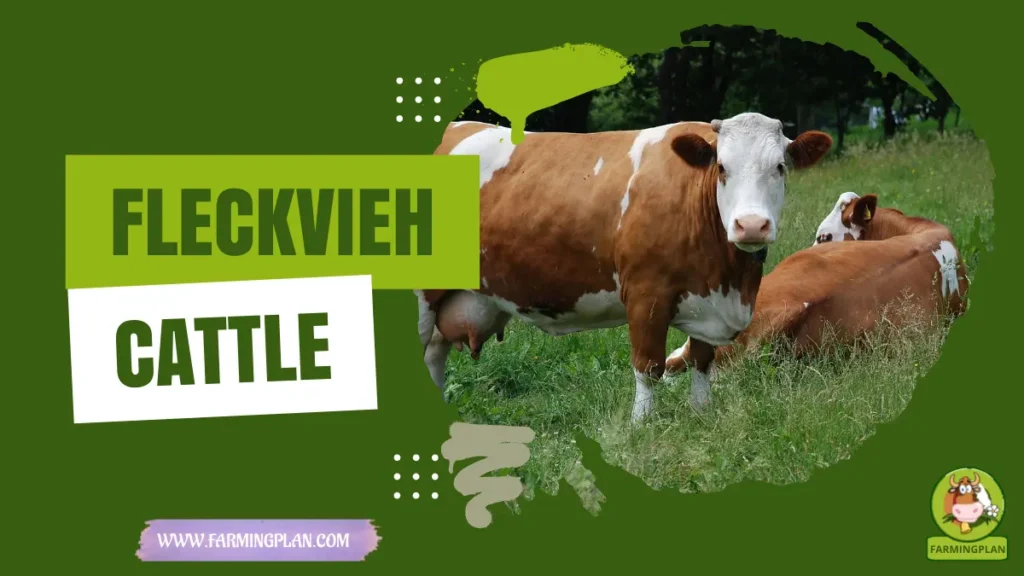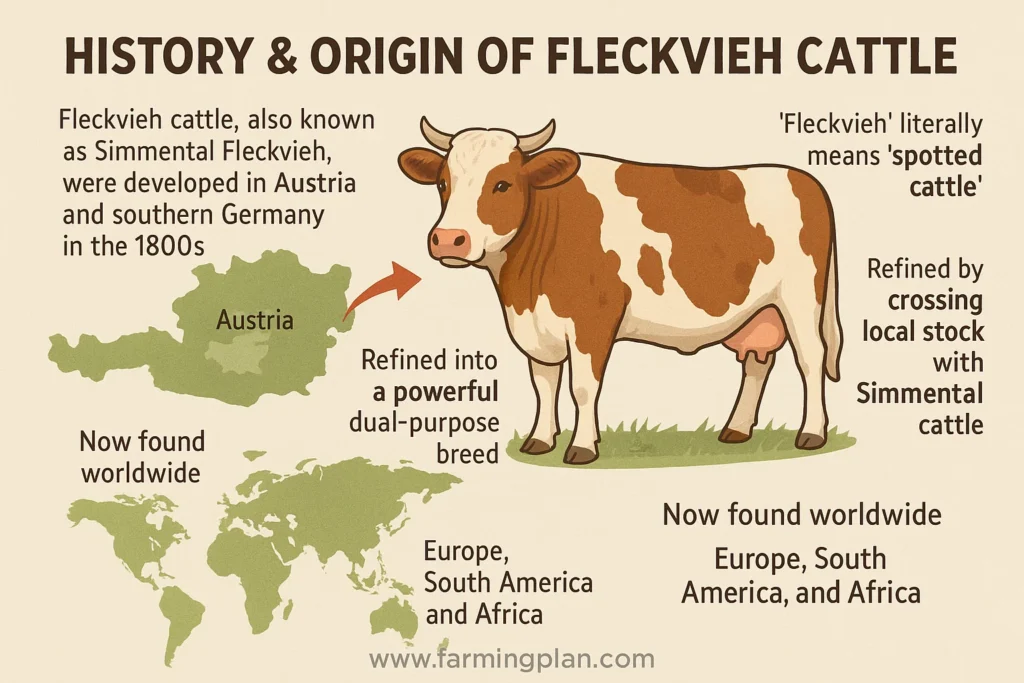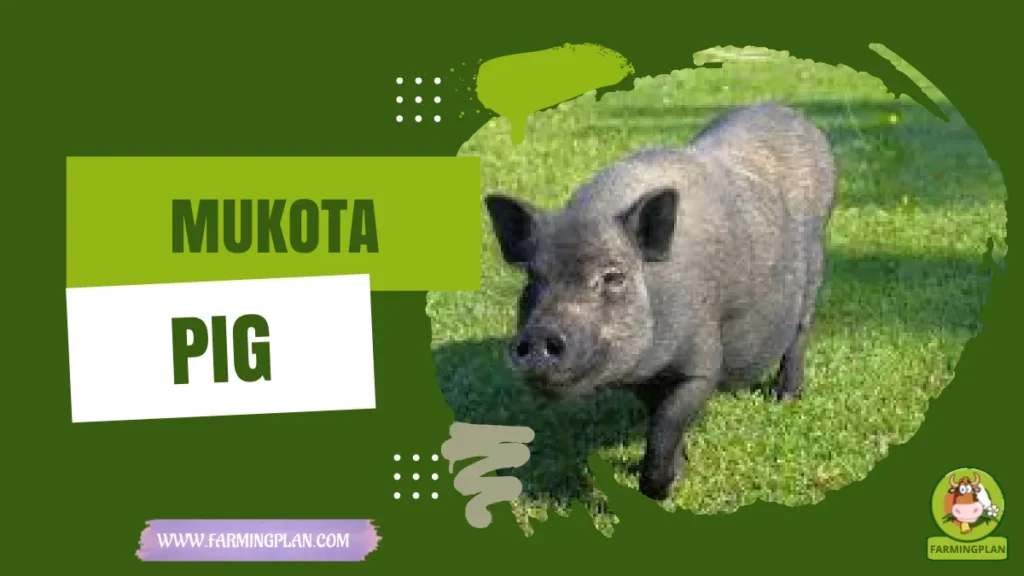If you’re after a breed that delivers both high-quality milk and solid beef, Fleckvieh Cattle are a smart choice. These medium-framed, robust animals are valued worldwide for their productivity, calm nature, and adaptability. As a farmer who’s worked with many breeds, I’ve grown to respect Fleckvieh not only for their impressive milk yields and strong calves but also for their gentle temperament and long working life. Whether you’re a small homesteader, efficiency-focused breeder, or just love well-rounded livestock, Fleckvieh ticks all the right boxes. Thinking about adding them to your herd? Stick around—I’ve got helpful tips and resources on finding Fleckvieh breeders and cows for sale.

History & Origin of Fleckvieh Cattle
Fleckvieh Cattle, also known as Simmental Fleckvieh, were developed in Austria and southern Germany back in the 1800s by crossing local stock with Simmental cattle. Over time, they were refined into a powerful dual-purpose breed through focused breeding programs, mostly in Austria. Their name “Fleckvieh” literally means “spotted cattle,” thanks to their unique reddish patches on white coats. The breed’s history is a testament to human ingenuity and the power of selective breeding to create a versatile and productive animal.

Originally bred for versatility, the aim was simple: create a cow that could provide both excellent milk yields and solid meat. Today, Fleckvieh has spread globally, with strong populations in Europe, South America, and Africa. The breed is gaining traction in places like the U.S. and Australia too, especially among those looking to improve herd performance, calving ease, and milk quality without relying heavily on traditional dairy breeds like Holstein.
Read More: Afrikaner Cattle: The Ultimate Hardy Breed for Heat, Strength & Superior Beef
Characteristics of Fleckvieh Cattle
Fleckvieh Cattle are known for their moderate frame, strong legs, and excellent muscling. They’re medium-sized animals, with cows weighing between 1,300 to 1,500 pounds and bulls tipping the scales up to 2,600 pounds. They’ve got solid feet, a deep chest, and a straight back—traits that translate into long productive lives and fewer vet visits.

Their color varies from light yellowish-red to dark red patches on white. Many folks notice their flat lactation curve—that means consistent milk flow across the cycle, ensuring a steady supply of milk for dairy producers. You’ll also see healthy udders, low somatic cell counts, and strong feed efficiency in most Fleckvieh cows under milk control programs.
Read More: Charolais Cattle: A French Breed
Temperament & Suitability of Fleckvieh Cattle
These cattle have a calm, friendly demeanor, which makes them easy to handle—even for beginners. I’ve found that even our young farmhands feel confident working around them. They’re social animals that thrive in herds and adjust well to new environments, whether that’s pasture grazing or confined barns.

Fleckvieh Cattle are also quite adaptable. From harsh alpine climates to hot, humid regions, they stay strong and productive. If you’re looking for cattle that won’t give you drama and are good around kids or other livestock, this breed checks out. Their adaptability makes them ideal for family farms, educational operations, and hobbyists alike, giving you peace of mind about your investment.
Read More: Angus Cattle: A Scottish Breed of Cattle
Food & Diet Needs
Feeding Fleckvieh Cattle right is key to unlocking their full potential. They thrive on quality forages, silage, and balanced grain rations. Thanks to their excellent feed conversion efficiency, you won’t need to go overboard with supplements to see strong milk yields or weight gains.
For milking cows, I offer a mix of high-energy feed and protein-rich legumes to support lactation. Don’t forget clean water—each cow can drink 30-50 gallons a day! Avoid moldy feed or sudden diet changes, as they can upset rumen health. Calves and heifers need extra care with consistent feeding routines for optimal growth.
What’s the Purpose of Fleckvieh Cattle?
The magic of Fleckvieh Cattle lies in its dual-purpose nature. Whether you need a solid milk-producing cow or a meaty steer for the market, Fleckvieh delivers. This versatility gives you confidence in your farming decisions, knowing that you can rely on this breed for both milk and meat production.
For the beef side, their calves fatten up well and have excellent carcass traits. Many farmers use them as beef sires or for dairy crosses like the F1 Holstein x Fleckvieh, which brings strong hybrid vigor. If you’re in a cattle production scheme aiming for efficiency, returns from milk, and meat, this breed is your partner.
What Makes Fleckvieh Cattle So Special?
There’s a reason Fleckvieh is called a universal breed. They combine the best of beef and dairy genetics, all while being easy to work with. Their unique qualities, such as the flat lactation curve, solid hoof health, and long productive life, make them an intriguing and interesting breed to work with.
Here are a few things I’ve come to admire:
- Excellent udder health reduces vet costs.
- Strong calves with rapid early growth.
- Great calving ease, especially in first lactation.
- Adaptability to different climatic conditions.
- Balanced breeding traits—meat, milk, and fertility.
Breeding programs often focus on genomic breeding values to improve performance, and many breeders offer Fleckvieh bulls for sale with strong pedigrees and milk performance data.
Strong, Calm, And Productive—Fleckvieh Cattle Make Every Farm Day Better.
Common Issues & Prevention Tips
Fleckvieh Cattle are generally hardy, but like all breeds, they can face health challenges. Mastitis, lameness, and reproductive issues are the big three to watch for. I keep an eye on hoof condition, especially in wet seasons, and maintain a regular trimming schedule to avoid foot problems. Somatic cell count is usually low, but regular testing ensures milk quality stays high. Vaccinations, deworming, and a mineral-rich diet are crucial for preventing issues. Don’t skip those pre- and post-calving checks either—healthy calvings mean healthy herds. With good management, you’ll rarely need the vet.
Step-by-Step Farming Guide – Raising Fleckvieh Cattle Like a Pro
Step 1: Set Up Your Farm Space for Fleckvieh
Before you bring in any animals, you need a solid setup. Fleckvieh need clean, spacious shelter, dry bedding, and room to roam. We rotate pastures regularly to manage manure and give grass time to recover. Keep water troughs clean and fences secure—these animals are strong and curious. Make sure you’ve got shelter from wind, rain, and heat. Ventilation in barns helps prevent respiratory problems, especially during calving season. Create separate pens for sick animals or new calves to avoid spreading illness.
Step 2: Choosing Your Cattle Wisely
Always get your stock from reputable Fleckvieh breeders. Whether you’re buying heifers, cows, or Fleckvieh bulls for sale, ask for milk recording data, health records, and breeding values. Look for moderate frame size, strong feet, and balanced body condition. Check the bull’s background if you’re planning to breed. A good sire should have traits like excellent feed efficiency, good calving intervals, and healthy daughters. Avoid animals with hoof problems, poor temperament, or fertility issues.
Step 3: Daily Care & Feeding Routine
Fleckvieh need routine and care. Every morning, we feed grain rations and inspect each cow’s eyes, feet, and udders. Offer hay or pasture throughout the day and ensure their salt and mineral blocks are within reach. Clean out manure daily—trust me, your herd will thank you. We also record milk production to track performance. Any dip in yields usually means something’s up—either with diet, weather, or health. Keep them calm, clean, and well-fed, and you’ll see top-tier milk and meat gains.
Step 4: Breeding, Calving & Growth Management
Start breeding at around 15-18 months, depending on weight and maturity. I use a mix of AI and natural sires based on my breeding goals. Watch closely during calving season. Fleckvieh cows usually deliver with ease, but having a vet on standby is always smart. After birth, dip the calf’s navel, provide colostrum, and monitor weight gain daily. At weaning, introduce grains slowly. Heifers should reach breeding size by 15 months if fed right. Keep track of calving intervals, lactation cycles, and breeding targets for better herd performance.
Expert Tips & Best Practices for Fleckvieh Success
- Rotate your pastures to reduce parasite load and protect forage.
- Always track milk performance to spot health or nutrition issues.
- Choose sires based on specific breeding aims—dairy vs. meat.
- Vaccinate and deworm consistently—don’t let your guard down.
- Cull underperformers to keep your herd efficient and profitable.
- Focus on foot health—sound feet mean long productive lives.
- Record calving data to improve genetic selection.
Tip: When in doubt, listen to your herd. They’ll tell you if something’s off—just not in words.
FAQ
Are Fleckvieh cattle good for both milk and meat?
Yes! Fleckvieh are a true dual-purpose breed, delivering high milk yields and excellent meat performance.
How much milk does a Fleckvieh cow produce?
On average, Fleckvieh cows produce about 17,000 lbs of milk per year, with rich protein and butterfat content.
Are Fleckvieh cows easy to manage?
Absolutely. They’re calm, friendly, and adaptable to different farm setups, making them ideal even for beginners.
Where can I find Fleckvieh cattle for sale?
You can check with local breeders, farming expos, or online listings. Look for registered Fleckvieh breeders with health records.
Do Fleckvieh calves grow quickly?
Yes. They show strong early growth and have great feed conversion, making them excellent for beef production.
Conclusion
Fleckvieh Cattle truly bring the best of both worlds—high milk performance and quality beef traits in one sturdy, friendly package. With their excellent health, calm nature, and efficient production, they’ve become a staple on farms like mine. Whether you’re breeding, milking, or just starting out, Fleckvieh makes every part of the journey easier and more rewarding. Ready to get started with this universal breed? Keep your eye out for trusted Fleckvieh for sale near you, and don’t hesitate to reach out to breeders for guidance. Trust me—once you meet your first Fleckvieh, you’ll be hooked.


